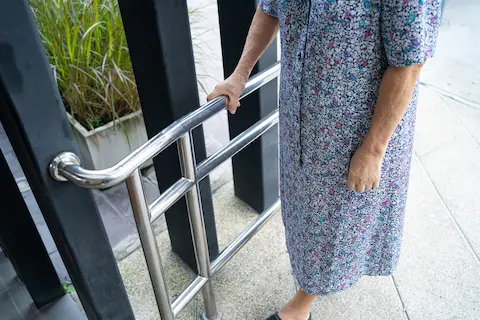As the population ages, the concept of “aging in place” has gained significant traction. This refers to the ability for older adults to live independently in their own homes for as long as possible. A pivotal aspect of making this a reality is the modification of living spaces to enhance accessibility and safety. Among these modifications, zero-barrier entries and rampscapes have emerged as crucial elements. This blog post will delve into what zero-barrier entries and rampscapes are, their benefits, and how they can significantly improve the quality of life for older adults.
Understanding Zero-Barrier Entries
Zero-barrier entries are designed to eliminate obstacles that can impede mobility, allowing for safe and easy access to the home. They focus on creating seamless transitions between the exterior and interior environments to minimize the risk of falls and enhance overall usability.
Key Features of Zero-Barrier Entries
1. Level Surfaces: The primary objective of a zero-barrier entry is to remove steps, curbs, or any other hindrances that could pose a risk to mobility. Level surfaces provide a smooth transition for anyone entering or exiting the home.
2. Gradual Slopes: Instead of steep ramps that can be challenging to navigate, zero-barrier entries utilize gentle slopes. This design accommodates various mobility levels, making it easier for individuals with walkers, wheelchairs, or those who may struggle with balance.
3. Wide Doorways and Hallways: To ensure accessibility, zero-barrier entries often incorporate wider doorways and hallways. This design consideration allows for easy navigation of mobility aids and provides a more comfortable living environment.
4. Non-Slip Surfaces: To further enhance safety, zero-barrier entries typically feature non-slip surfaces. This design element is crucial in reducing the risk of falls, particularly in wet or icy conditions.
The Importance of Zero-Barrier Entries
Zero-barrier entries are not just a matter of convenience; they are essential for promoting independence and safety among older adults. According to the Centers for Disease Control and Prevention (CDC) (https://www.cdc.gov/homeandrecreationalsafety/falls/adultfalls.html), falls are the leading cause of injury among older adults. By minimizing barriers in the home, the risk of falls can be significantly reduced, allowing individuals to maintain their independence longer.
Exploring Rampscapes
While zero-barrier entries focus primarily on safety and accessibility, rampscapes take this concept a step further by integrating ramps into the overall landscape and architecture of a home. Rampscapes are innovative designs that emphasize aesthetics, functionality, and safety.
Key Characteristics of Rampscapes
1. Integrated Design: Ramps in rampscapes are seamlessly incorporated into the home’s design. They often blend with landscaping elements to create an inviting entrance that does not look out of place.
2. Variety of Materials: Rampscapes can utilize various materials, such as wood, concrete, and composite materials. This variety allows homeowners to customize rampscapes to match their home’s exterior, enhancing curb appeal.
3. Natural Aesthetics: Landscaping elements like plants, stones, and decorative features are used to soften the appearance of ramps. This design approach makes ramps more visually appealing, transforming them from purely functional structures into beautiful landscape features.
4. Multi-Functional Spaces: Beyond providing access, rampscapes can serve dual purposes, functioning as patios or walkways. This addition provides extra outdoor living space while ensuring accessibility.
Benefits of Rampscapes
The integration of rampscapes into home design offers numerous benefits, particularly for older adults and individuals with mobility challenges.
1. Enhanced Safety: By providing a stable entry point, rampscapes reduce the risk of falls, which can lead to severe injuries.
2. Increased Independence: Accessible entries empower older adults, enabling them to navigate their homes without assistance. This fosters a sense of autonomy that is vital for mental well-being.
3. Improved Property Value: Homes equipped with zero-barrier entries and rampscapes are often more attractive to buyers. As the demand for accessible living solutions continues to rise, these modifications can significantly enhance property value.
The Role of Home Modifications in Aging in Place
Home modifications play a crucial role in enabling older adults to age in place. According to the National Association of Home Builders (NAHB)(https://www.nahb.org/), nearly 90% of seniors prefer to remain in their homes as they age. However, as mobility challenges arise, it becomes necessary to adapt living spaces to ensure safety and accessibility.
Understanding the Aging Process
As individuals age, they may experience a decline in physical abilities. This decline can affect strength, balance, and coordination, making traditional home designs less suitable. Home modifications, such as zero-barrier entries and rampscapes, can mitigate these challenges, allowing for greater independence.
The Impact on Quality of Life
Research has shown that home modifications can significantly improve the quality of life for older adults. A study conducted by the Journal of Aging & Social Policy (https://www.tandfonline.com/) found that modifications that enhance accessibility can lead to improved mental health outcomes, reduced feelings of isolation, and increased overall life satisfaction.
Planning for Zero-Barrier Entries and Rampscapes
When considering zero-barrier entries and rampscapes for aging in place, several factors should be taken into account to ensure the modifications meet the needs of the residents.
Assessing Individual Needs
Each individual’s mobility needs will vary based on their health status and lifestyle. Conducting an assessment can help identify specific requirements, such as the need for wider doorways or gradual slopes.
Consulting with Professionals
Engaging with professionals who specialize in aging in place modifications can provide valuable insights. Occupational therapists, architects, and contractors experienced in accessible design can guide homeowners in making informed decisions.
Budget Considerations
While investing in zero-barrier entries and rampscapes can enhance safety and accessibility, it’s essential to consider budget constraints. Homeowners should explore various options and materials to find solutions that fit within their financial means.
Case Studies: Successful Implementations
Examining real-life examples of zero-barrier entries and rampscapes can provide inspiration and insight for homeowners looking to make similar modifications.
Case Study 1: The Thompson Residence
The Thompson family decided to modify their home after recognizing the mobility challenges faced by their aging parents. They installed a zero-barrier entry featuring a gradual slope and wide doorways. The results included enhanced accessibility and increased independence for their parents, who could now navigate the home without assistance.
Case Study 2: The Garcia Family’s Rampscape
The Garcia family chose to implement a rampscape in their backyard. They integrated a wooden ramp with landscaping elements, creating a beautiful outdoor space that also served as an accessible entry to their home. This modification not only improved safety but also added aesthetic value to their property.
Conclusion
As the trend of aging in place continues to grow, zero-barrier entries and rampscapes represent a crucial evolution in home modification practices. By prioritizing accessibility, safety, and aesthetic appeal, these innovations help create environments where older adults can thrive independently and comfortably in their own homes.
The focus on seamless integration of ramps into the home and landscape not only addresses functional needs but also enhances the overall quality of life for aging individuals. With the right modifications, homes can become safe havens that empower older adults to maintain their dignity and independence for years to come.
Take the Next Step
If you are considering making modifications to your home for aging in place, start by assessing your specific needs and consulting with professionals. Investing in zero-barrier entries and rampscapes can transform your living space into a more accessible and enjoyable environment, ensuring that you or your loved ones can age in place safely and comfortably.



